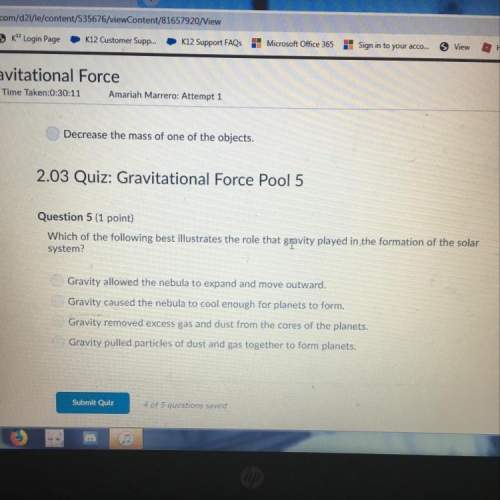PLZ HELP ME 2parts
Question 1 (1 point)
What would happen if a plant could carry out photosy...

PLZ HELP ME 2parts
Question 1 (1 point)
What would happen if a plant could carry out photosynthesis, but not respiration?
Question 1 options:
It would have no food.
It would have too much water.
It would be unable to capture the energy in sunlight.
It could make food but not break it down for energy.
Question 2 (1 point)
During photosynthesis, the following reaction takes place:
carbon dioxide + water + light energy → sugar + oxygen
During cellular respiration, the following reaction takes place:
sugar + oxygen → carbon dioxide + water + chemical energy
Given this information, how are photosynthesis and cellular respiration related?
Question 2 options:
The products of photosynthesis are the reactants of cellular respiration.
Photosynthesis and cellular respiration both start with the same materials.
Photosynthesis and cellular respiration both produce the same materials.
The same type of energy is found in both photosynthesis and cellular respiration.
Question 3 (1 point)
What process controls water loss by the plant, so that the plant will not wither up and die?
Question 3 options:
Respiration
Transpiration
Restoration
Photosynthesis
Question 4 (1 point)
Plants must break down the sugar in cells to obtain energy from the food that is produced. What is this process called?
Question 4 options:
Respiration
Transpiration
Restoration
Photosynthesis
Question 5 (1 point)
Which equation correctly describes photosynthesis?
Question 5 options:
water + sugar + oxygen → carbon dioxide + chlorophyll
sunlight + water + carbon dioxide → oxygen + sugar
sunlight + sugar → water + oxygen
carbon dioxide + oxygen → water + sugar + sunlight
Question 6 (1 point)
Which statement is a correct description of the processes of respiration and transpiration in a plant?
Question 6 options:
Transpiration is when the plant loses water through its leaves. Respiration is when the plant breaks down the sugar in its cells to release energy.
Transpiration is when the plant pulls water into its roots. Respiration is when the plant breathes.
Transpiration is when the plant grows over time. Respiration is when the plant breaks down the sugar in its roots.
Transpiration is when the plant produces buds. Respiration is when the plant dies.
Question 7 (1 point)
The diagram below represents a chloroplast found in a typical plant cell.
Which of the following processes occurs inside this structure?
Question 7 options:
Oxygen is produced
Sunlight is trapped
Glucose is produced
All of the above.
Question 8 (1 point)
slow down transpiration by the stomata
Question 8 options:
Guard cells; closing
Chloroplasts; closing
Guard cells; opening
Chloroplasts; opening
Question 9 (1 point)
The diagram below illustrates which of the following plant processes.
Question 9 options:
Photosynthesis
Phototropism
Respiration
Pollination
Question 10 (1 point)
What part of the chloroplasts helps to absorb light in order for the plant to make its own food?
Question 10 options:
chlorophyll
stomata
guard cells
photosynthotons
Question 11 (1 point)
Which of the following is not true of mosses, liverworts, and hornworts?
Question 11 options:
They are non-vascular plants.
They have true roots, stems, and leaves.
They grow in moist places.
They are small and low-growing.

Answers: 1
Another question on Chemistry

Chemistry, 22.06.2019 10:10
When electrolyzing copper (ll) chloride, what reaction takes place at the anode? what reaction takes place at the cathode?
Answers: 1

Chemistry, 22.06.2019 12:30
If 22.5 liters of oxygen reacted with excess of hydrogen, how many liters of water vapor could be produced?
Answers: 3

Chemistry, 22.06.2019 16:10
Given the following equation: 2a1 + 3mgcl2 --> 2alcl3 + 3mg how many moles of aluminum chloride are produced from 2.5 moles of magnesium chloride?
Answers: 1

Chemistry, 22.06.2019 21:40
A5 mole sample of liquid acetone is converted to a gas at 75.0°c. if 628 j are required to raise the temperature of the liquid to the boiling point, 15.600 kj are required to evaporate the liquid, and 712 j are required to raise the final temperature to 75.0°c, what is the total energy required for the conversion?
Answers: 3
You know the right answer?
Questions








Social Studies, 09.07.2020 02:01







Mathematics, 09.07.2020 02:01

Computers and Technology, 09.07.2020 02:01







